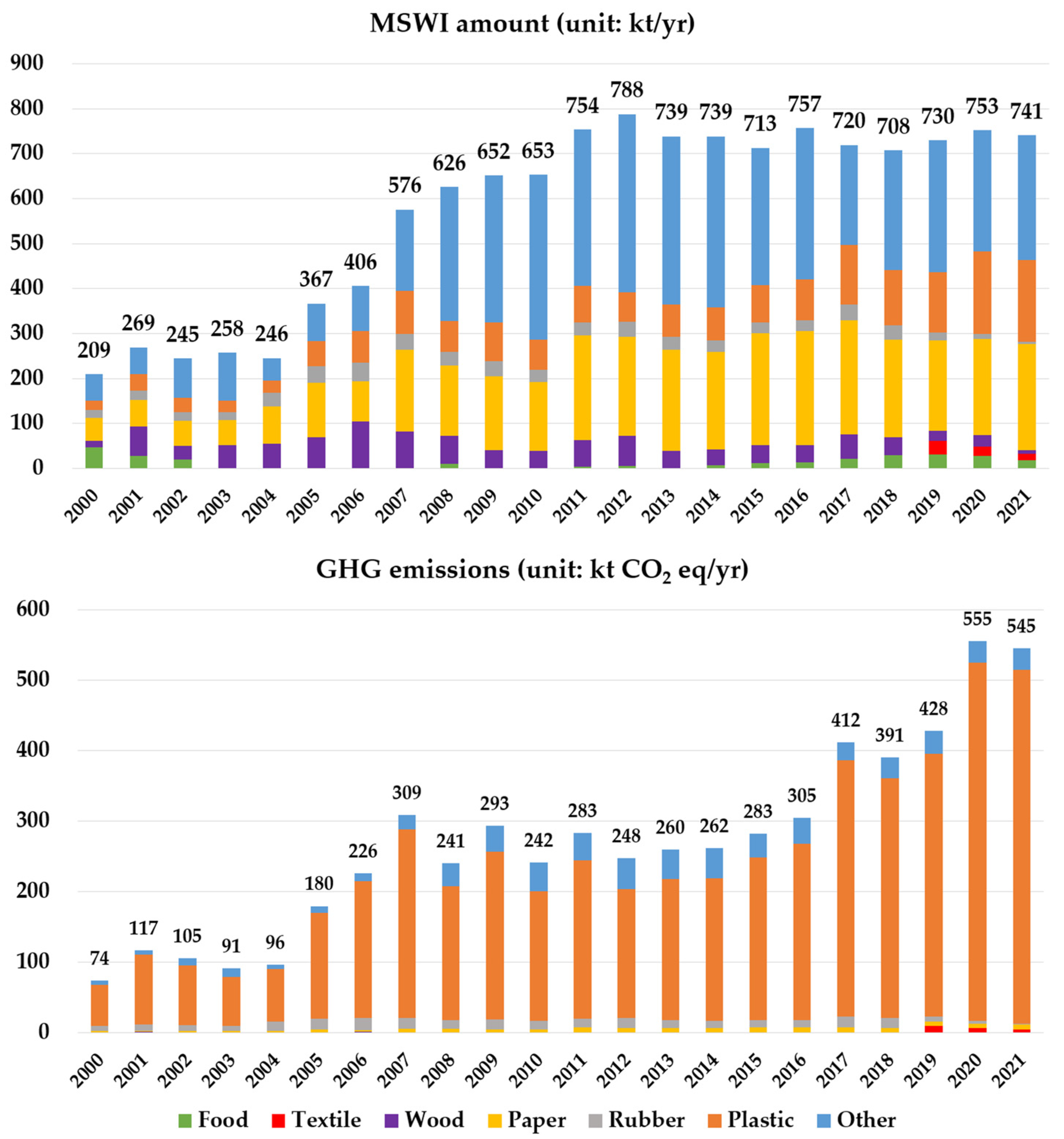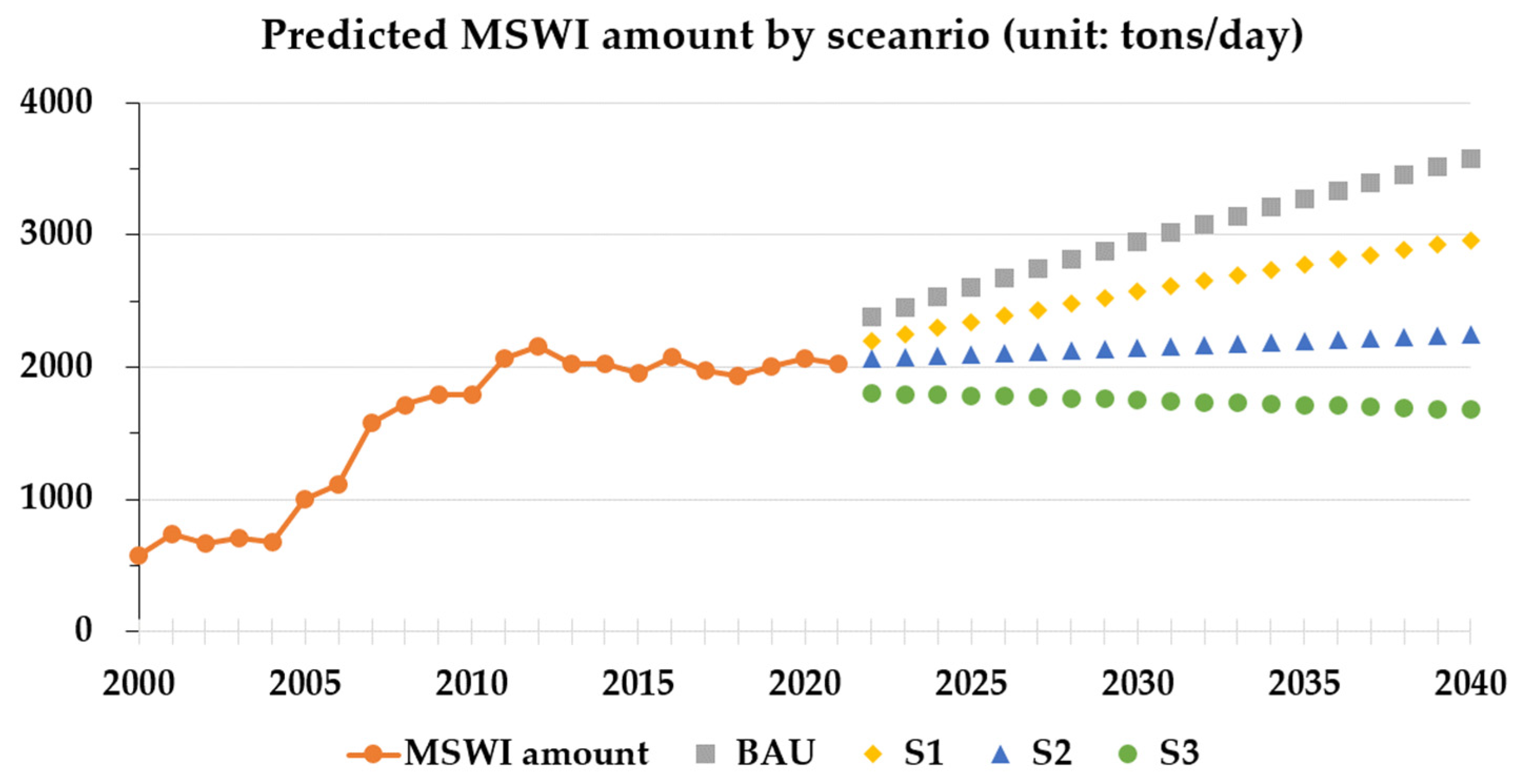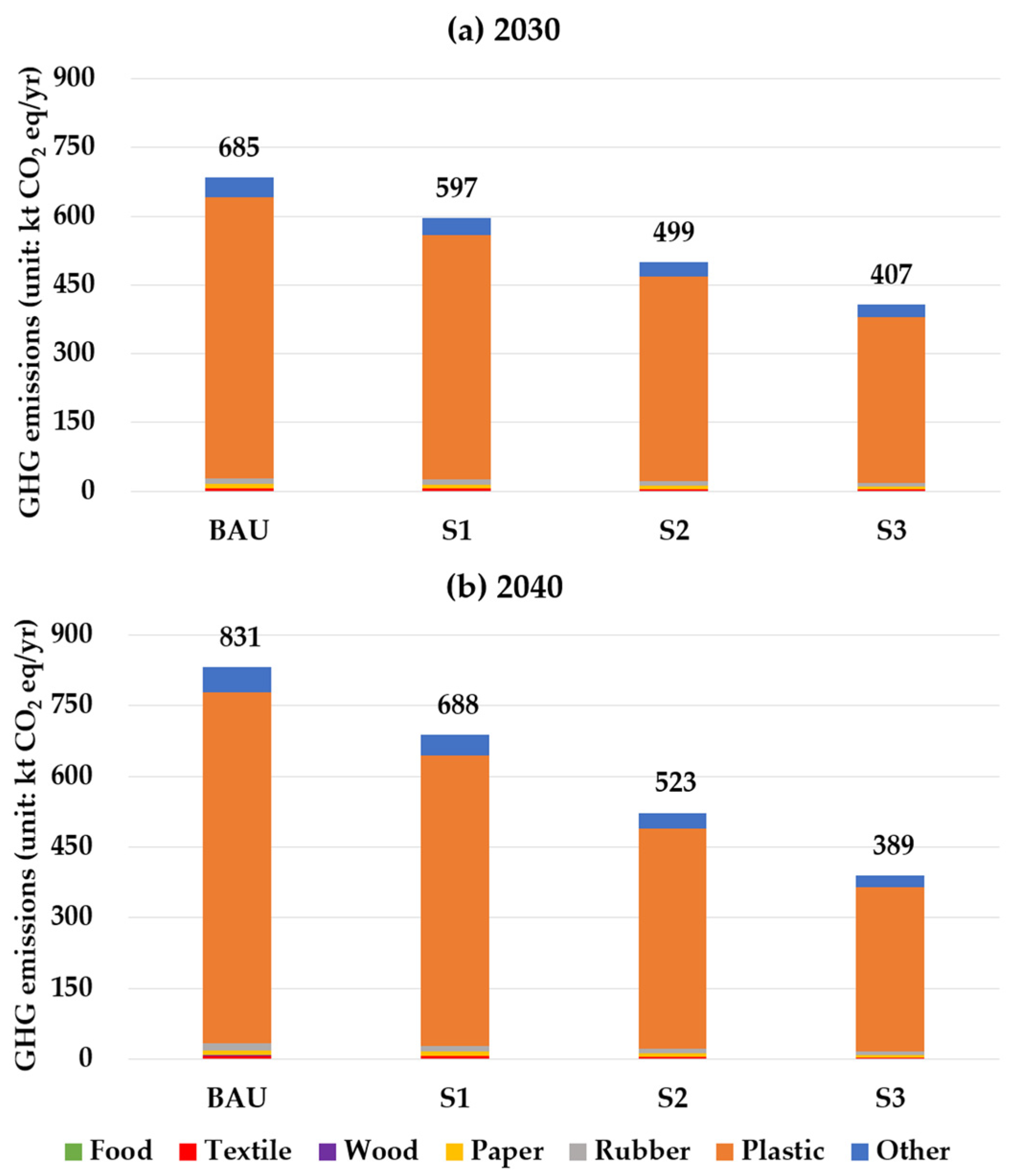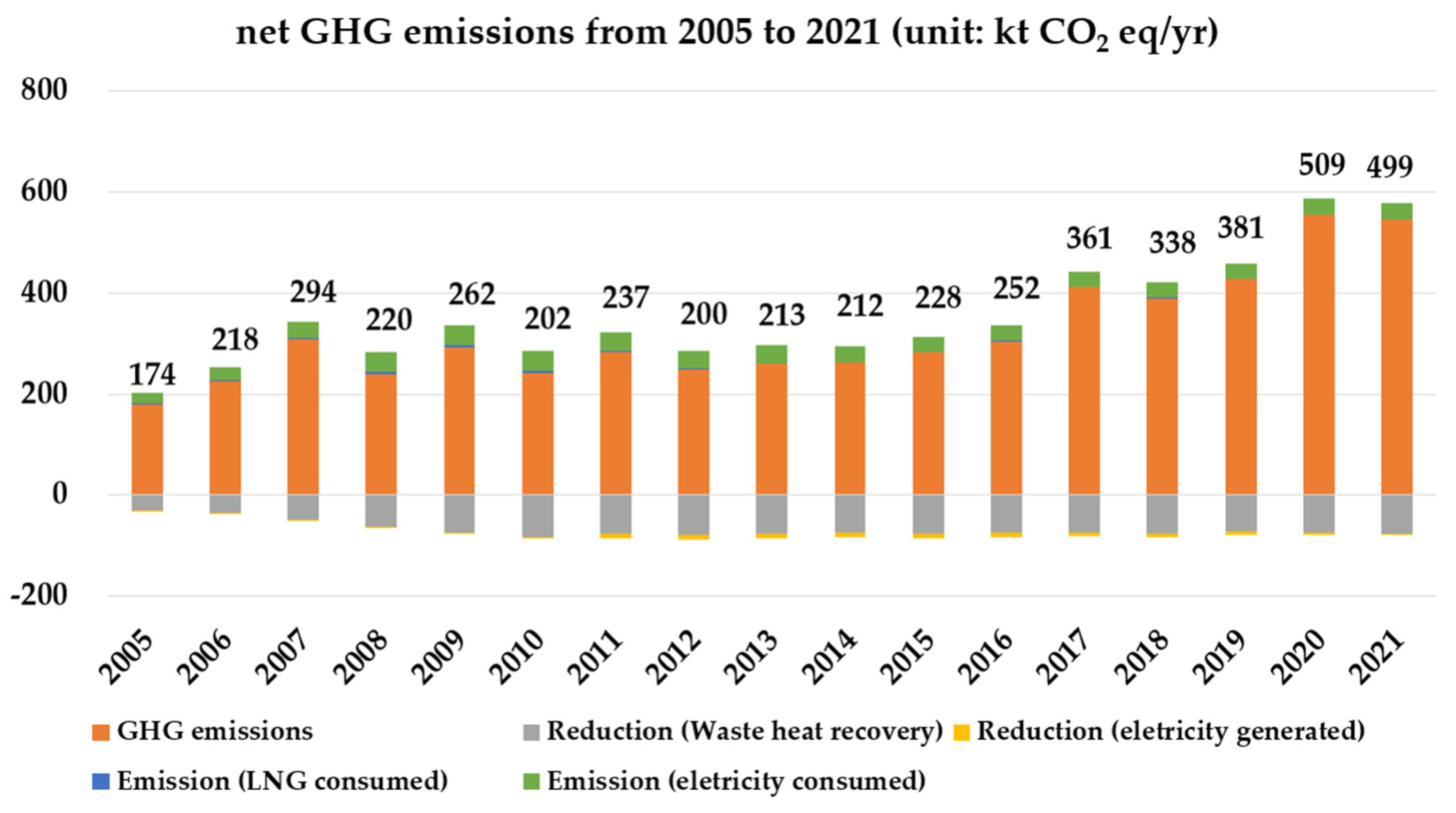Greenhouse Gas Emissions from Incineration of Municipal Solid Waste in Seoul, South Korea
Abstract
1. Introduction
2. Methodology
2.1. Data Acquisition
2.2. Calculation of GHG Emissions by Incineration
2.3. Scenario Analysis
2.4. Calculation of Net GHG Emissions by Incineration
3. Results and Discussion
3.1. Esimated GHG Emissions from MSWI from 2000 to 2021
3.2. Predicted GHG Emissions from MSWI in 2030 and 2040
3.2.1. Predicted Amounts of MSWI by Scenario Analysis
3.2.2. Predicted GHG Emissions by Scenario Analysis
3.3. Predicted Net GHG Emissions from MSWI from 2005 to 2040
4. Conclusions
Author Contributions
Funding
Data Availability Statement
Acknowledgments
Conflicts of Interest
References
- Intergovernmental Panel on Climate Change (IPCC). Good Practice Guidance and Uncertainty Management in National Greenhouse Gas Inventories; IPCC: Geneva, Switzerland, 2001; Chapter 5; p. 5.25. [Google Scholar]
- Pablo, E.E.-G.; Raúl, H.C.-L.; Carrasco-Hernández, R.; Emmanuel, F.-R.; Jesús, M.L.-H. Technical and economic analysis of energy generation from waste incineration in Mexico. Energy Strat. Rev. 2020, 31, 100542. [Google Scholar] [CrossRef]
- Hwang, K.-L.; Choi, S.-M.; Kim, M.-K.; Heo, J.-B.; Zoh, K.-D. Emission of greenhouse gases from waste incineration in Korea. J. Environ. Manag. 2017, 196, 710–718. [Google Scholar] [CrossRef] [PubMed]
- Intergovernmental Panel on Climate Change (IPCC). 2006 IPCC Guidelines for National Greenhouse Gas Inventories, Prepared by the National Greenhouse Gas Inventories Programme; Eggleston, H.S., Buendia, L., Miwa, K., Ngara, T., Tanabe, K., Eds.; IGES: Kanagawa, Japan, 2006; Volume 5. [Google Scholar]
- Kweku, D.W.; Bismark, O.; Maxwell, A.; Desmond, K.A.; Danso, K.B.; Oti-Mensah, E.A.; Quachie, A.T.; Adormaa, B.B. Greenhouse Effect: Greenhouse Gases and Their Impact on Global Warming. J. Sci. Res. Rep. 2018, 17, 1–9. [Google Scholar] [CrossRef]
- United Nations Environment Programme (UNEP). Emissions Gap Report 2022; UNEP: New York, NY, USA, 2022; p. XII. ISBN 978-92-807-3979-4. [Google Scholar]
- Yang, N.; Zhang, H.; Chen, M.; Shao, L.-M.; He, P.-J. Greenhouse gas emissions from MSW incineration in China: Impacts of waste characteristics and energy recovery. Waste Manag. 2012, 32, 2552–2560. [Google Scholar] [CrossRef] [PubMed]
- Yao, X.; Guo, Z.; Liu, Y.; Li, J.; Feng, W.; Lei, H.; Gao, Y. Reduction potential of GHG emissions from municipal solid waste incineration for power generation in Beijing. J. Clean. Prod. 2019, 241, 118283. [Google Scholar] [CrossRef]
- Kadir, S.A.S.A.; Yin, C.-Y.; Sulaiman, M.R.; Chen, X.; El-Harbawi, M. Incineration of municipal solid waste in Malaysia: Salient issues, policies and waste-to-energy initiatives. Renew. Sustain. Energy Rev. 2013, 24, 181–186. [Google Scholar] [CrossRef]
- Yaman, C.; Anil, I.; Alagha, O. Potential for greenhouse gas reduction and energy recovery from MSW through different waste management technologies. J. Clean. Prod. 2020, 264, 121432. [Google Scholar] [CrossRef]
- Lino, F.A.M.; Ismail, K.A.R. Incineration and recycling for MSW treatment: Case study of Campinas, Brazil. Sustain. Cities Soc. 2017, 35, 752–757. [Google Scholar] [CrossRef]
- Zhao, Y.; Xing, W.; Lu, W.; Zhang, X.; Christensen, T.H. Environmental impact assessment of the incineration of municipal solid waste with auxiliary coal in China. Waste Manag. 2012, 32, 1989–1998. [Google Scholar] [CrossRef] [PubMed]
- Korea Ministry of Environment (Korea MOE). Annual Statistics of Waste Generation and Treatment (2000–2021); Korea Ministry of Environment (Korea MOE): Sejong, Republic of Korea, 2023. (In Korean) [Google Scholar]
- Korea Ministry of Environment (Korea MOE). National Greenhouse Gas Statistics (1990~2020); Korea Ministry of Environment (Korea MOE): Sejong, Republic of Korea, 2023. (In Korean) [Google Scholar]
- Kang, S.; Roh, J.; Cho, C.; Lee, H.S.; Jeon, E.-C. Analysis of Factors for Emission Change in the Waste Incineration Sector caused by Change of Guidance in the Greenhouse Gas Emissions Estimate Method. J. Clim. Chang. Res. 2019, 10, 35–46. [Google Scholar] [CrossRef]
- Kwon, Y.; Chang, Y.; Jang, Y.-C. Estimation of Greenhouse Gas Reduction by Resource and Energy Recovery of Municipal Solid Waste (MSW). J. Korea Soc. Waste Manag. 2018, 35, 525–532. [Google Scholar] [CrossRef]
- Park, S.; Choi, J.-H.; Park, J. The estimation of N2O emissions from municipal solid waste incineration facilities: The Korea case. Waste Manag. 2011, 31, 1765–1771. [Google Scholar] [CrossRef] [PubMed]
- Kim, S.; Kang, S.; Lee, J.; Lee, S.; Kim, K.-H.; Jeon, E.-C. The comparison of fossil carbon fraction and greenhouse gas emissions through an analysis of exhaust gases from urban solid waste incineration facilities. J. Air Waste Manag. Assoc. 2016, 66, 978–987. [Google Scholar] [CrossRef] [PubMed]
- Hathout, D. Modeling Population Growth: Exponential and Hyperbolic Modeling. Appl. Math. 2013, 4, 299–304. [Google Scholar] [CrossRef]
- Yu, Y.; Du, Y. Impact of technological innovation on CO2 emissions and emissions trend prediction on ‘New Normal’ economy in China. Atmos. Pollut. Res. 2019, 10, 152–161. [Google Scholar] [CrossRef]
- Moharir, S.; Bondre, A.; Vaidya, S.; Patankar, P.; Kanaskar, Y.; Karne, H. Comparative Analysis of the Amount of Biogas Produced by Different Cultures using the Modified Gompertz Model and Logistic Model. Eur. J. Sustain. Dev. Res. 2020, 4, em0141. [Google Scholar] [CrossRef]
- Seoul Metropolitan Government. Resource Recovery Facility Operation Status. Available online: https://rrf.seoul.go.kr/content/bcreb228.do (accessed on 29 April 2023).
- Korea Environment Corporation (KECO). Greenhouse Gas Emission and Energy Consumption in Waste Sector Calculation Tool (Ver. 2.44 (2016.02.23)); Korea Environment Corporation (KECO): Incheon, Republic of Korea, 2023. (In Korean) [Google Scholar]
- Korea Ministry of Environment (Korea MOE). 2030 National Greenhouse Gas Reduction Targets(NDC); Korea Ministry of Environment (Korea MOE): Sejong, Republic of Korea, 2021. (In Korean) [Google Scholar]
- Korea Ministry of Environment (Korea MOE). Disposable Bag Waste to Be Banned from Direct Landfills in the Capital Region Starting in 2026; Korea Ministry of Environment (Korea MOE): Sejong, Republic of Korea, 2021. (In Korean) [Google Scholar]
- National Institute of Environment Research. A Study on Setting Greenhouse Gas Reduction Target by Recycling Waste (III); National Institute of Environment Research: Incheon, Republic of Korea, 2012. [Google Scholar] [CrossRef]
- Korea Ministry of Environment (Korea MOE). National Carbon Emission Factor; Korea Ministry of Environment (Korea MOE): Sejong, Republic of Korea, 2022. (In Korean) [Google Scholar]
- Japan Ministry of Environment (Japan MOE). Waste Management in Japan; Japan Ministry of Environment (Japan MOE): Tokyo, Japan, 2020. (In Japanese) [Google Scholar]
- Korea Ministry of Environment (Korea MOE). Direct Landfill Ban on Food Waste Since 2005; Korea Ministry of Environment (Korea MOE): Sejong, Republic of Korea, 2004. (In Korean) [Google Scholar]
- United States Environmental Protection Agency (US EPA). Greenhouse Gas Inventory Guidance: Direct Emissions from Stationary Combustion Sources. Available online: https://www.epa.gov/sites/default/files/2020-12/documents/stationaryemissions.pdf (accessed on 29 April 2023).
- Park, S.-W. Diagnosis and Improvement Strategies of Greenhouse Gases Reduction Policies in the Waste Sector of Seoul; Seoul Institute of Technology: Seoul, Republic of Korea, 2022; ISBN 979-11-92456-51-5. [Google Scholar]
- Walker, S.; Rothman, R. Life cycle assessment of bio-based and fossil-based plastic: A review. J. Clean. Prod. 2020, 261, 121158. [Google Scholar] [CrossRef]
- Liao, N.; Bolyard, S.C.; Lü, F.; Yang, N.; Zhang, H.; Shao, L.; He, P. Can waste management system be a Greenhouse Gas sink? Perspective from Shanghai, China. Resour. Conserv. Recycl. 2022, 180, 106170. [Google Scholar] [CrossRef]
- Organization for Economic Co-Operation and Development (OECD). Global Plastics Outlook: Policy Scenarios to 2060; OECD: Paris, France, 2022; ISBN 978-92-64-89881-3. [Google Scholar] [CrossRef]
- van der Hulst, M.K.; Ottenbros, A.B.; van der Drift, B.; Špela, F.; van Harmelen, T.; Schwarz, A.E.; Worrell, E.; van Zelm, R.; Huijbregts, M.A.; Hauck, M. Greenhouse gas benefits from direct chemical recycling of mixed plastic waste. Resour. Conserv. Recycl. 2022, 186, 106582. [Google Scholar] [CrossRef]
- Sevigné-Itoiz, E.; Gasol, C.M.; Rieradevall, J.; Gabarrell, X. Contribution of plastic waste recovery to greenhouse gas (GHG) savings in Spain. Waste Manag. 2015, 46, 557–567. [Google Scholar] [CrossRef]
- Heron, K.; Søren, D. 100 Years of Waste Incineration in Denmark. Available online: https://ramboll.com/-/media/files/rgr/documents/markets/energy/waste-to-energy/100-years-of-waste-incineration-in-denmark.pdf?la=en (accessed on 29 April 2023).
- European Commission. A New Circular Economy Action Plan for a Cleaner and More Competitive Europe. Available online: https://environment.ec.europa.eu/topics/waste-and-recycling/landfill-waste_en (accessed on 29 April 2023).
- Wang, K.; Nakakubo, T. Comparative assessment of waste disposal systems and technologies with regard to greenhouse gas emissions: A case study of municipal solid waste treatment options in China. J. Clean. Prod. 2020, 260, 120827. [Google Scholar] [CrossRef]
- Su, X.; Zhang, L.; Xiao, Y.; Sun, M.; Gao, X.; Su, J. Evaluation of a flue gas cleaning system of a circulating fluidized bed incineration power plant by the analysis of pollutant emissions. Powder Technol. 2015, 286, 9–15. [Google Scholar] [CrossRef]
- Vukovic, N.; Makogon, E. Waste-to-Energy Generation: Complex Efficiency Analysis of Modern Technologies. Sustainability 2022, 14, 13814. [Google Scholar] [CrossRef]
- Kristanto, G.A.; Koven, W. Estimating greenhouse gas emissions from municipal solid waste management in Depok, Indonesia. City Environ. Interact. 2019, 4, 100027. [Google Scholar] [CrossRef]
- Korea Greenpeace and Chungnam National University. 2023 Plastic Korea 2.0. 2023. Available online: https://www.greenpeace.org/korea/update/25774/report-disposable-korea-ver2/ (accessed on 25 May 2023). (In Korean).
- Chen, Y.; Awasthi, A.K.; Wei, F.; Tan, Q.; Li, J. Single-use plastics: Production, usage, disposal, and adverse impacts. Sci. Total Environ. 2021, 752, 141772. [Google Scholar] [CrossRef]







| Category | Year of Data | References |
|---|---|---|
| National generation amount of waste disposal bags in MSW in Seoul (non-recyclables) | 2000~2021 | Korea MOE, 2000~2021 [13] |
| National treatment statistics of waste disposal bags in MSW in Seoul (landfill and incineration) | 2000~2021 | Korea MOE, 2000~2021 [13] |
| Operational data on MSW incineration facilities in Seoul | 2005~2022 | Seoul Metropolitan Government, 2005~2022 [22] |
| Type | Dry Mass (dm) | Carbon Fraction (CF) | Fossil Carbon Fraction (FCF) | Oxidation Factor (OF) | Emission Factor (EF) | ||
|---|---|---|---|---|---|---|---|
| CO2 (t CO2/ t Waste) | CH4 (kg CH4/ t Waste) | N2O (g N2O/ t Waste) | |||||
| Food | 0.40 | 0.38 | 0.00 | 1.0 | 0.0000 | 0.0002 | 39.8 |
| Textile | 0.80 | 0.50 | 0.20 | 0.2931 | |||
| Wood | 0.85 | 0.50 | 0.00 | 0.0000 | |||
| Paper | 0.90 | 0.46 | 0.01 | 0.0152 | |||
| Rubber | 0.84 | 0.67 | 0.20 | 0.4124 | |||
| Plastic | 1.00 | 0.75 | 1.00 | 2.7480 | |||
| Other | 0.90 | 0.03 | 1.00 | 0.0989 | |||
| Category | Assumptions for Scenario | |||
|---|---|---|---|---|
| Business-as-usual (BAU) scenario | No landfilling of disposable (non-recyclable) waste after 2026 | |||
| Assumptions for S1~S3 |
| |||
| Category | Scenario 1 (S1) | Scenario 2 (S2) | Scenario 3 (S3) | |
| (Assumption 2) Target reduction rate of disposable waste in MSW by 2040 | 10% | 20% | 30% | |
| (Assumption 3) Ratio of recycling and incineration | Recycling | 0% | 50% | 100% |
| Incineration | 100% | 50% | 0% | |
| Category | Emission Factor | Unit | Reference |
|---|---|---|---|
| Power generation | 0.4403 | t CO2 eq/MWh | Korea MOE (2022) [27] |
| Power consumption | 0.4747 | t CO2 eq/MWh | |
| LNG | 15.236 | t C/TJ |
| Category | Incineration Status | Energy Sales | Energy Consumption | ||||
|---|---|---|---|---|---|---|---|
| Daily Input Amounts (Tons/Day) | Daily Incinerated Amounts (Tons/Day) | Operation Rate * (%) | Waste Heat (Gcal) | Electricity (Generated) (kWh) | LNG (Nm3) | Electricity (Consumed) (kWh) | |
| Gangnam | 888 | 793 | 88 | 442,989 | 0 | 333,830 | 26,491,356 |
| Nowon | 591 | 551 | 69 | 247,936 | 0 | 234,133 | 16,629,469 |
| Mapo | 629 | 589 | 78 | 795,452 | 7,878,847 | 263,414 | 18,957,875 |
| Yangcheon | 406 | 341 | 85 | 171,365 | 2,479,464 | 664,489 | 8,733,110 |
| Total | 2514 | 2274 | 80 (average) | 1,157,742 | 10,358,311 | 1,495,866 | 70,811,810 |
Disclaimer/Publisher’s Note: The statements, opinions and data contained in all publications are solely those of the individual author(s) and contributor(s) and not of MDPI and/or the editor(s). MDPI and/or the editor(s) disclaim responsibility for any injury to people or property resulting from any ideas, methods, instructions or products referred to in the content. |
© 2023 by the authors. Licensee MDPI, Basel, Switzerland. This article is an open access article distributed under the terms and conditions of the Creative Commons Attribution (CC BY) license (https://creativecommons.org/licenses/by/4.0/).
Share and Cite
Kwon, Y.; Choi, K.; Jang, Y.-C. Greenhouse Gas Emissions from Incineration of Municipal Solid Waste in Seoul, South Korea. Energies 2023, 16, 4791. https://doi.org/10.3390/en16124791
Kwon Y, Choi K, Jang Y-C. Greenhouse Gas Emissions from Incineration of Municipal Solid Waste in Seoul, South Korea. Energies. 2023; 16(12):4791. https://doi.org/10.3390/en16124791
Chicago/Turabian StyleKwon, Youngsun, Kyunghoon Choi, and Yong-Chul Jang. 2023. "Greenhouse Gas Emissions from Incineration of Municipal Solid Waste in Seoul, South Korea" Energies 16, no. 12: 4791. https://doi.org/10.3390/en16124791
APA StyleKwon, Y., Choi, K., & Jang, Y.-C. (2023). Greenhouse Gas Emissions from Incineration of Municipal Solid Waste in Seoul, South Korea. Energies, 16(12), 4791. https://doi.org/10.3390/en16124791








